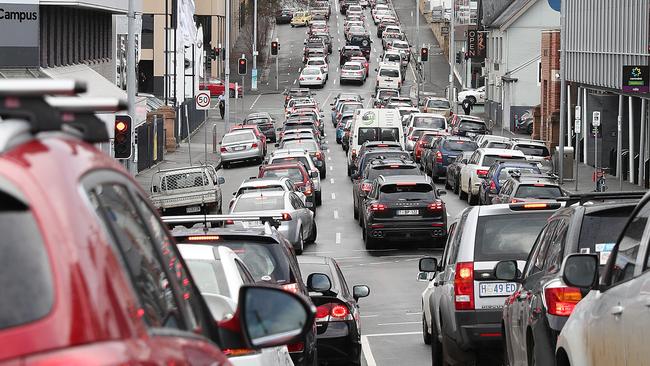RACT floats ideas to ease city congestion
TASMANIA’S peak motoring body has put up a range of scenarios under which Hobart’s traffic congestion could be eased and is looking for public input.

Lifestyle
Don't miss out on the headlines from Lifestyle. Followed categories will be added to My News.
TASMANIA’S peak motoring body has put up five scenarios under which Hobart’s traffic congestion could be eased and is looking for public input.
From quick-fix solutions to traffic pinch points to making Hobart a city focused on river transport, the scenarios are sure to get people talking.
The RACT, which received more than 70 submissions in response to its Greater Hobart Mobility Vision, held a public forum on Monday night and an online survey has been launched to let people have their say.
@UTAS_ ' @CityByrne: a ferry network on the River Derwent would be cost-effective, carbon-neutral and put Hobart on the map. Would include terminals, smart timetables, bicycles access, first and last mile links with autonomous buses #RACTforum #mobilityvision #politas #auspol pic.twitter.com/Nb5SR1ZPX3
— RACT (@RACTOfficial) November 19, 2018
Under scenario one, it would be business as usual in Hobart with quick-fix projects undertaken when traffic pinch points arise. There would be a small investment in public transport to make an immediate impact. The growth of Hobart would focus on detached housing in new developments with investment in infrastructure as density allows.
Scenario two involves large-scale investment in roads to alleviate congestion. Options include bypasses, larger highways, more lanes and extra car parks. Higher capacity road networks would support residential development in outlying suburbs and money would be spent on public and active transport.
Panelist Anna Lyth: Hobart can improve mobility through mode shift with light rail or trackless trams, high frequency bus services, incentives, park and ride, cycleways and walkways, plus high density housing integrated with services #RACTforum #mobilityvision #auspol #politas pic.twitter.com/wacJvtlaRA
— RACT (@RACTOfficial) November 19, 2018
Scenario three focuses on encouraging a shift to public and active transport.
Car parks and parking stations would be moved to the CBD fringe and urban settlement would involve compact urban and CBD development around public transport. Active transport would be separated from motorised traffic.
Under its fourth scenario, Hobart would see big change with current roads converted into shared spaces. Cars would be encouraged out with rapid transit services operating to key routes using low or zero emission and autonomous vehicles. Vehicle movements in the CBD would be limited and high-density housing would be built.
Under scenario five, Hobart would become a river city with a heavy reliance on the River Derwent as the primary means of mobility. There would be an extensive ferry network serving population centres. Settlement would be focused on areas serviced by the ferry network.
RACT chief executive Harvey Lennon said the organisation had not formed a view about which scenario was best.
The survey is available at hobartvision.ract.com.au.


